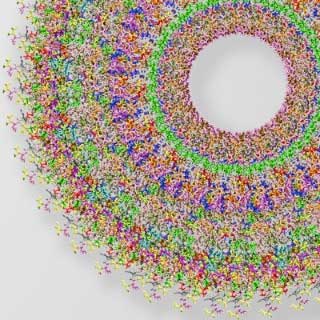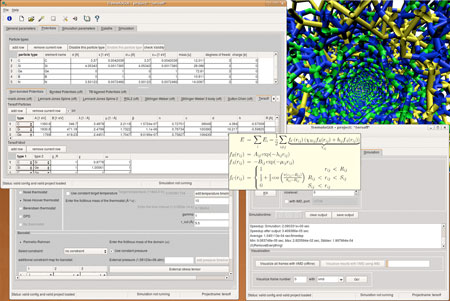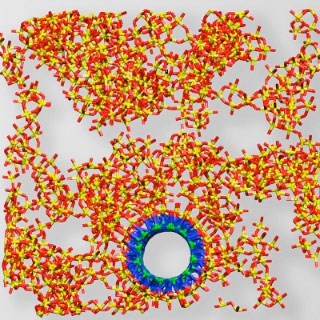| Posted: Apr 03, 2018 |
From the quantum level to the car battery
(Nanowerk News) New developments require new materials. Until recently, these have been developed mostly by tedious experiments in the laboratory. Researchers at the Fraunhofer Institute for Algorithms and Scientific Computing SCAI in Sankt Augustin are now significantly shortening this time-consuming and cost-intensive process with their "Virtual Material Design" approach and the specially developed Tremolo-X software. By combining multi-scale models, data analysis and machine learning, it is possible to develop improved materials much more quickly. At the Hanover Trade Fair from April 23 to 27, 2018, Fraunhofer will be demonstrating how the virtual material design of the future looks (Hall 6, Booth A30).
|
 |
| Even tiny objects can be depicted in detail: here an atomistic model of the tobacco mosaic virus. The tubular virus is about 300 nm long and 18 nm in diameter. (Image: Fraunhofer SCAI)
|
|
In almost every industry, new materials are needed for new developments. Let's take the automotive industry: while an automobile used to consist of just a handful of materials, modern cars are assembled from thousands of different materials – and demand is increasing.
|
|
Whether it's making a car lighter, getting better fuel economy or developing electric motor batteries, every new development requires finding or developing the material that has exactly the right properties. The search for the right material has often been like a guessing game, though. The candidates have usually been selected from huge material databases and then tested.
|
|
Although these databases provide insight into specific performance characteristics, they usually do not go far enough into depth to allow meaningful judgments about whether a material has exactly the desired properties. To find that out, numerous laboratory tests have to be performed.
|
|
The scientists at the Fraunhofer SCAI have chosen a different approach. The requirements for the substance are broken down to the inner structure of the material: that is, down to the atomic level. A specially developed software, Tremolo-X, then calculates how the particles of the material react when subjected to certain physical effects. As a result, it can be concluded whether a material with the desired properties can be developed on the basis of these particles.
|
 |
| Graphical user interface of the Fraunhofer SCAI Software Tremolo-X. (Image: Fraunhofer SCAI) (click on image to enlarge)
|
Virtual predictive models and atomistic simulations
|
|
"Our goal is to shorten the search for the right material. This process often takes ten to twenty years, which is not only time consuming but also costly," says Dr. Jan Hamaekers from the Fraunhofer SCAI. "The idea is to use virtual processes to sift out the number of candidates until there are only a few left to be tested in the lab."
|
|
To do this, the requirements placed on the material first have to be defined. For example, how fast a material has to cool down or what loads it has to withstand. This is simulated in two different ways on computer by using the Fraunhofer software: virtual particles are simulated at the atomic or even at the quantum level. How do they behave? How do the particles interact with each other?
|
|
The other method uses existing data and knowledge to derive prediction models that make it possible to forecast the properties of a material. "The aim is to improve, create and explore new innovative materials and molecules with effective properties in the virtual computer lab in order to recommend their structure and design prior to the actual synthesis," Hamaekers explains.
|
Multiscale modeling: from the atom to the process chain
|
|
The procedure becomes clear during multi-scale modeling, as used in the chemical industry (among others). Here, the chemistry of the material is first described at the quantum level. This information is transferred to ever coarser models that map molecules and their physical properties.
|
 |
| Boron nitride nanotubes in a silica matrix. Representation of reinforced nanomaterials with the Fraunhofer software. (Image: Fraunhofer SCAI)
|
|
"If we want to predict how good the electrolyte is or how fast the ions are diffusing in the case of a lithium-ion battery, for example, we first simulate the particles at the quantum level and see what happens to them. Then, we take that information to the next level and gain insight into the dynamics, or how the particles move at the atomic level. From here, we can then go up a scale and look at how the electrolyte behaves in the macroscopic world. This gives us precise insights into all the processes and, if necessary, we can adapt or change processes," Hamaekers explains.
|
|
In this way, not only can new materials be developed or suitable materials found for specific applications. Even processes can be reviewed and improved. By simulating the processes at the atomic or molecular level in a virtual reactor, it is possible to precisely identify the points or parameters that can be optimized.
|
|
At the 2018 Hanover Trade Fair, the Fraunhofer SCAI uses vivid examples to show how the design of materials can be improved through modeling, data analysis and machine learning.
|

